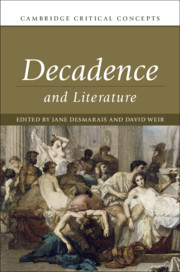Book contents
- Decadence and Literature
- Cambridge Critical Concepts
- Decadence and Literature
- Copyright page
- Dedication
- Contents
- Figures
- Contributors
- Acknowledgements
- Introduction
- Part I Origins
- Part II Developments
- Chapter 8 Decadence and the Visual Arts
- Chapter 9 Decadence and Music
- Chapter 10 Decadence, Parody, and New Women’s Writing
- Chapter 11 The Philosophy of Decadence
- Chapter 12 The Sexual Psychology of Decadence
- Chapter 13 The Theology of Decadence
- Chapter 14 The Science of Decadence
- Chapter 15 The Sociology of Decadence
- Part III Applications
- Select Bibliography
- Index
- References
Chapter 9 - Decadence and Music
from Part II - Developments
Published online by Cambridge University Press: 12 August 2019
- Decadence and Literature
- Cambridge Critical Concepts
- Decadence and Literature
- Copyright page
- Dedication
- Contents
- Figures
- Contributors
- Acknowledgements
- Introduction
- Part I Origins
- Part II Developments
- Chapter 8 Decadence and the Visual Arts
- Chapter 9 Decadence and Music
- Chapter 10 Decadence, Parody, and New Women’s Writing
- Chapter 11 The Philosophy of Decadence
- Chapter 12 The Sexual Psychology of Decadence
- Chapter 13 The Theology of Decadence
- Chapter 14 The Science of Decadence
- Chapter 15 The Sociology of Decadence
- Part III Applications
- Select Bibliography
- Index
- References
Summary
The idea of decadent music may be as old as music itself, dating back at least to classical antiquity. This chapter offers a history of the concept from the classical period through the Middle Ages, the Renaissance, and the eighteenth century, before concentrating on the explosion of the idea across Europe from the mid-nineteenth century onwards. Classical writings often invoke a model of music that can be understood as proto-decadent ? for which read morally ‘bad’, formally flawed, hyper-affective, enervating, or corrupting in some way ? even if the term itself is not used. Then, as later, decadent music was perceived and defined by its effect on its listeners or by its formal properties, as Nietzsche understood Wagnerian opera in the nineteenth century. Music, it seems, has always been understood to contain the potential to disrupt and contaminate itself and its audience, requiring aesthetic, social, even state control ? control articulated via the idea of decadence.
- Type
- Chapter
- Information
- Decadence and Literature , pp. 152 - 168Publisher: Cambridge University PressPrint publication year: 2019
References
- 1
- Cited by



